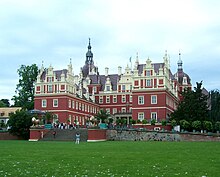Prince Frederick of the Netherlands
| Prince Frederick | |
|---|---|
 | |
| Born | 28 February 1797 Berlin |
| Died | 8 September 1881 (aged 84) Wassenaar |
| Spouse | Princess Louise of Prussia |
| Issue | Louise, Queen of Sweden and Norway Prince Frederik Prince Willem Marie, Princess of Wied |
| House | Orange-Nassau |
| Father | William I of the Netherlands |
| Mother | Wilhelmine of Prussia |
| Religion | Dutch Reformed Church |
Prince Frederick of the Netherlands, Prince of Orange-Nassau (full names: Willem Frederik Karel; Berlin, 28 February 1797 – Wassenaar, 8 September 1881), was the second son of William I of the Netherlands and his wife, Wilhelmine of Prussia.
Early life
The prince grew up at the court of his grandfather Frederick William II of Prussia and uncle Frederick William III of Prussia. One of his tutors was Carl von Clausewitz. Aged 16, the prince fought in the Battle of Leipzig.
The prince first entered the Netherlands in December 1813. As he spoke no Dutch, the prince was sent to Leiden University to get a further education. He was also educated by Karl Ludwig von Phull in The Hague. When Napoleon returned from Elba, during the Hundred Days the prince was given command of a detachment of Wellington's army which was posted in a fall back position near Braine-le-Comte should the battle taking place at Waterloo be lost.
Prince of the Netherlands
Based on a house treaty, Frederick was to inherit the family's German possessions upon his father's death. After the treaty of Vienna these were no longer in the possession of the family. He instead was made heir to the Grand Duchy of Luxemburg. In 1816, Frederick relinquished this claim in exchange for land in the Netherlands and the title of Prince of the Netherlands. As a further compensation he received a yearly amount of 190,000 Dutch guilder.[1] This made him the wealthiest member of the House of Orange-Nassau.[1] With the money he bought a large estate in Germany, which made him the largest land owner from the Netherlands.[1]
In 1826 Frederick was appointed Commissary-general of the Department of War. In this office, Frederick reorganized the army on a Prussian model. Frederick founded the military academy in Breda and reequipped the army with modern weapons.
In 1829 Frederick was a candidate for the Greek throne, but he declined because he did not want to be king of a country whose language and traditions were foreign to him.
When the Belgian Revolution broke out in 1830, Frederick commanded the troops sent to Brussels to suppress the rebellion there. Frederick led these troops in several days of fighting in Brussels, but could not retake the city. Frederick also took part in his brother's 1831 Ten Days' Campaign in Belgium.


When his father abdicated in 1840, Frederick withdrew from public life to his estates at Wassenaar. In 1846 he acquired Schloss Muskau in Prussia where he completed Muskau Park, the largest and one of the most famous English gardens in Central Europe, stretching along both sides of the present German–Polish border on the Lusatian Neisse. The park had been laid out from 1815 onwards at the behest of Prince Hermann von Pückler-Muskau (1785–1871). In July 2004, Muskau Park was added to the list of UNESCO World Heritage Sites.
Upon the death of his elder brother in 1849, the country was left with a large debt. Frederick managed to pay off a million guilder to Tsar Nicholas I of Russia, who was brother-in-law to William II.[1] The new King William III of the Netherlands did not want to inherent the kingship from his father, but Frederick managed to convince him to take up the position, offering to assist him.[1] William III recalled Frederick and made him Inspector-General of the army. Frederick held that office until 1868, when he resigned because of the lack of support for his plans to modernize the army. Frederick managed to prevent a divorce between King William III and Queen Sophie of Württemberg by establishing a legal separation.[1] He retired to Muskau Castle which was remodeled in Renaissance revival style between 1863 and 1866.
Marriage
Prince Frederick married in Berlin on 21 May 1825 his first cousin Louise, daughter of Frederick William III of Prussia. They had four children:
- Wilhelmina Frederika Alexandrine Anna Louise (The Hague, 5 August 1828 – Stockholm, 30 March 1871), married in Stockholm on 19 June 1850 to Charles XV of Sweden (Stockholm, 3 May 1826 - Malmö, 18 September 1872)
- Willem Frederik Nicolaas Karel (The Hague, 6 July 1833 - The Hague, 1 November 1834)
- Willem Frederik Nicolaas Albert (The Hague, 22 August 1836 - The Hague, 23 January 1846)
- Wilhelmina Frederika Anna Elisabeth Maria Marie (Huize De Paauw, Wassenaar, 5 July 1841 - Neuwied, 22 June 1910), married in Wassenaar on 18 July 1871 to William, Prince of Wied (Neuwied, 22 August 1845 - Neuwied, 22 October 1907). They were parents of William, Prince of Albania.
Titles and Styles
- 1797 – 1881: His Royal Highness Prince Frederik of the Netherlands, Prince of Orange-Nassau
Ancestry
References
- ^ a b c d e f Lambert Teuwissen (10 May 2015). "'Prins Frederik was beter dan onze eerste koningen'" (in Dutch). Nederlandse Omroep Stichting. Retrieved 12 May 2015.
- 1797 births
- 1881 deaths
- Dutch members of the Dutch Reformed Church
- Members of the Council of State (Netherlands)
- Inspectors general
- People from Berlin
- House of Orange-Nassau
- Royal Netherlands Navy admirals
- Royal Netherlands Navy officers
- Royal Netherlands Army generals
- Royal Netherlands Army officers
- Ministers of War of the Netherlands
- People from the Margraviate of Brandenburg
- Burials in the Royal Crypt at Nieuwe Kerk, Delft
- Knights Grand Cross of the Military William Order
- Dutch princes
- Dutch Freemasons
- Dutch military personnel of the Napoleonic Wars
- Colonel generals of Prussia
